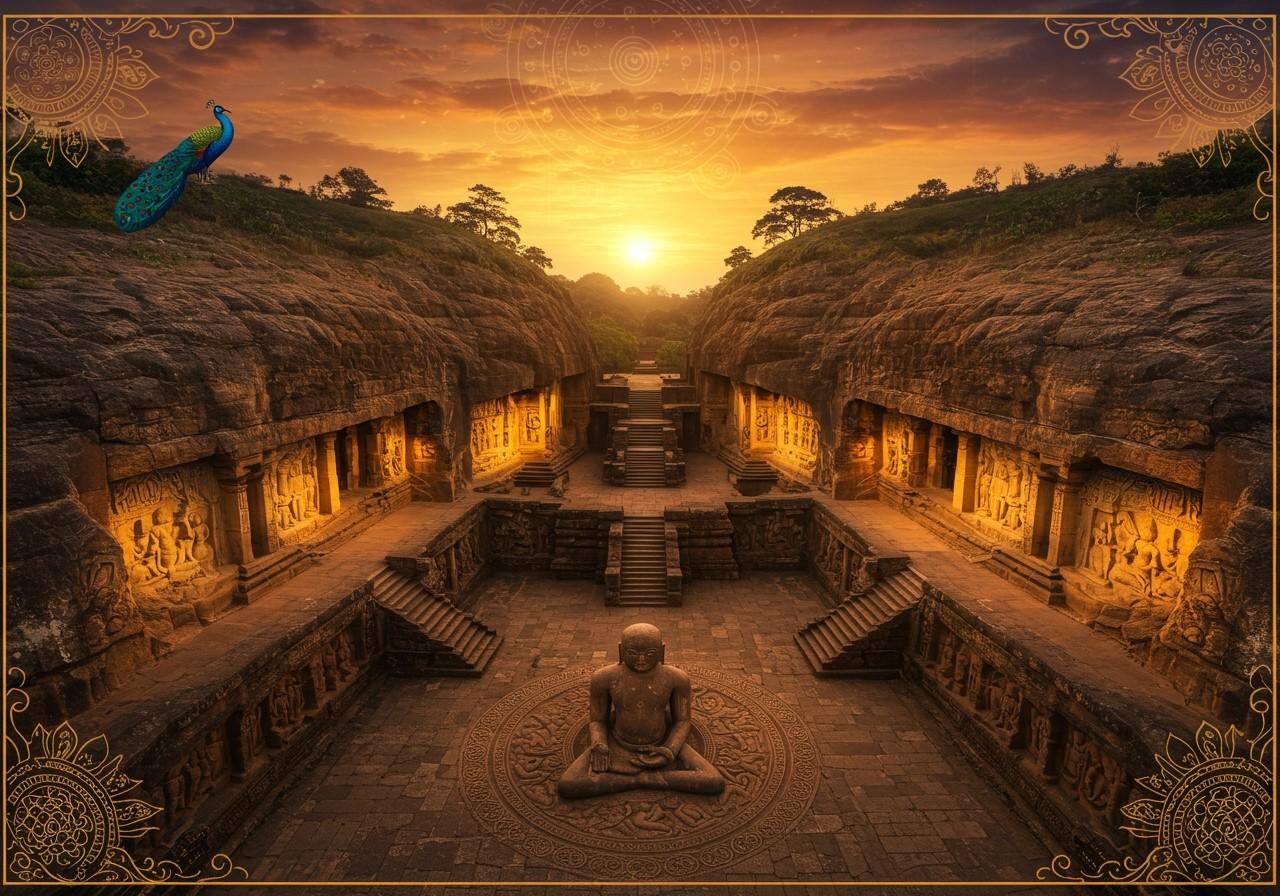
The Udayagiri and Khandagiri Caves, near Bhubaneswar, Odisha, stand as a testament to India’s rich history and cultural heritage. Carved into two adjacent hills, these rock-cut shelters offer a captivating glimpse into the past. These caves, primarily associated with Jainism, date back to the 2nd century BCE, during the reign of King Kharavela.
A Deep Dive into History
These caves trace their origins back to the 2nd century BCE, a period marked by the rule of King Kharavela of the Mahameghavahana dynasty. A fervent patron of Jainism, King Kharavela played a pivotal role in the caves’ development. Serving as both living quarters and meditation spaces for Jain monks, the caves bear intricate carvings and inscriptions that reflect the tenets of Jain philosophy. This historical context underscores the significant influence of Jainism and the caves’ importance as religious hubs.
Architectural Marvels
The architecture of the Udayagiri and Khandagiri Caves is truly remarkable. The cave walls are adorned with a rich tapestry of carvings and inscriptions, depicting religious figures, animals, and scenes from daily life. The craftsmanship displayed in these rock-cut structures speaks volumes about the skill and artistry of ancient Indian artisans.
Some key caves to explore include:
- Rani Gumpha (Queen’s Cave): Known for its elaborate carvings and spacious layout, the Rani Gumpha is a visual treat. It offers a glimpse into the artistic sensibilities of the time.
- Hathi Gumpha (Elephant Cave): This cave houses a significant inscription detailing the accomplishments of King Kharavela. It provides valuable historical context for understanding his reign and the era.
Cultural and Religious Significance
The Udayagiri and Khandagiri Caves played a crucial role in the propagation of Jainism. They functioned as centers for religious practices and education. The inscriptions within the caves offer invaluable insights into the socio-religious customs of ancient India.
Within the broader narrative of Indian religious history, these caves hold a place of distinction, comparable to other significant religious sites of the time. They provide a unique window into the cultural and religious landscape of ancient India.
Notable Caves and Inscriptions
Several caves within the Udayagiri and Khandagiri complex are particularly noteworthy:
- Rani Gumpha: Renowned for its artistic carvings, the Rani Gumpha is a must-see for its aesthetic beauty.
- Hathi Gumpha: Containing the famous inscription chronicling King Kharavela’s reign, this cave offers significant historical value.
These inscriptions not only hold artistic importance but also provide glimpses into the achievements of King Kharavela and the cultural practices of his era.
Visitor Information
Planning a visit to the Udayagiri and Khandagiri Caves? Here’s what you need to know:
Location and Accessibility: The caves are situated near Bhubaneswar, Odisha, easily accessible by air, rail, and road. From Bhubaneswar, you can reach the caves by private car, auto-rickshaw, or public transport.
Best Time to Visit: The ideal time to visit is from November to February when the weather is pleasant. This ensures a comfortable and enjoyable experience exploring the caves.
Timings and Entry Fee: The caves are open from sunrise to sunset daily. The entry fee is INR 15 for Indian visitors.
Tips for Visitors: Wear comfortable walking shoes, carry water, and wear sun protection (hats, sunscreen). Consider hiring a guide for a more enriching experience, as they can provide valuable insights into the historical and cultural significance of the caves.
Poojn.in: Enhancing Your Spiritual Journey
Poojn.in, India’s leading online store for cultural and religious goods, offers a wide selection of items to enhance your visit to the Udayagiri and Khandagiri Caves. We provide authentic puja items that align with the Jain traditions associated with the caves, including:
- Incense Holders: Pure copper and brass incense holders perfect for creating a meditative atmosphere.
- Cotton Wicks (Batti): Traditional cotton wicks for lighting diyas, essential for traditional rituals.
- Camphor Tablets: Natural camphor tablets for aarti, adding a sacred touch to your prayers.
- Pure Ghee: Pure ghee in sealed containers for lamp offerings, ensuring purity and convenience.
- Incense Sticks: Organic incense sticks crafted with natural ingredients, promoting a serene ambiance.
- Meditation Mats and Cushions: Meditation mats and cushions for comfortable prayer sessions, enhancing your spiritual experience.
Visit poojn.in to explore our complete collection or contact our customer service for any specific needs related to your cave temple visit. We deliver across India, ensuring convenient access to these essential items.
Conclusion
A visit to the Udayagiri and Khandagiri Caves is a journey through time, offering a profound connection to India’s ancient past. Plan your visit during the winter months (November-February) for the best experience. Remember essentials like water, comfortable shoes, and sun protection. Hiring a guide can greatly enhance your understanding and appreciation of these remarkable caves. Embrace the opportunity to explore these magnificent caves and create lasting memories of your exploration of India’s rich heritage.


